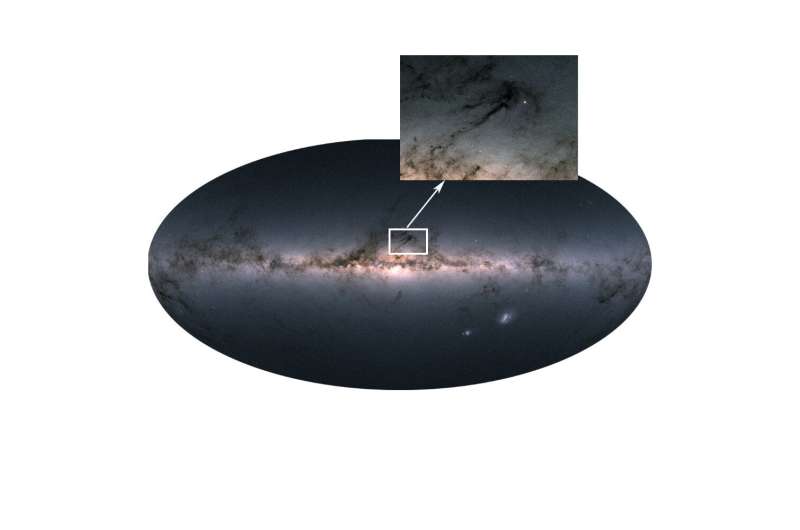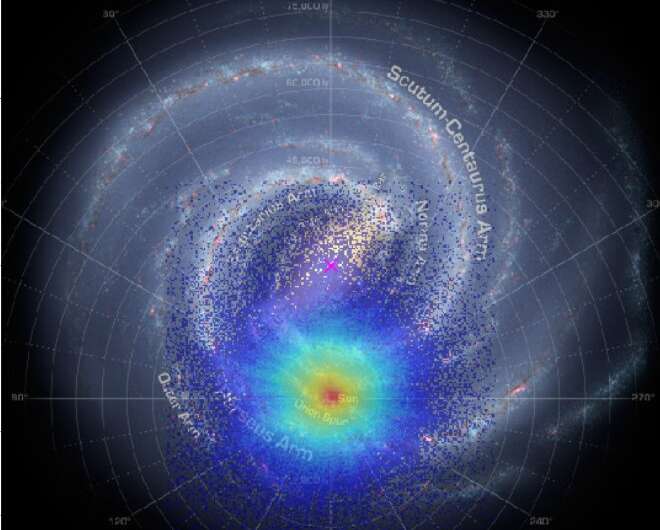Star formation burst in the Milky Way 2–3 billion years ago (Update)

A team led by researchers of the Institute of Cosmos Sciences of the University of Barcelona (ICCUB, UB-IEEC) and the Besançon Astronomical Observatory have analyzed data from the Gaia satellite and found that a heavy star formation burst occurred in the Milky Way about 3,000 million years ago. During this process, more than 50 percent of the stars that created the galactic disc may have been born. These results are derived from the combination of the distances, colors and magnitude of the stars that were measured by Gaia with models that predict their distribution in our galaxy. The study has been published in the journal Astronomy & Astrophysics.
Like a flame fades when there is no gas in the cylinder, the rhythm of the stellar formation in the Milky Way, fueled by deposited gas, is predicted to decrease slowly and in a continuous way as the existing gas is extinguished. The results of the study show that although this process took place over the first 4,000 million years of Milky Way disc formation, a severe star formation burst, or "stellar baby boom," inverted this trend. A gas-rich satellite galaxy merged with the Milky Way, and could have introduced new fuel and reactivated the process of stellar formation. This mechanism would explain the distribution of distances, ages and masses that are estimated from the data taken from the European Space Agency Gaia satellite.
"The time scale of this star formation burst, together with the great stellar mass involved in the process—thousands of millions of solar masses—suggests the disc of our galaxy did not have a steady and paused evolution. It may have suffered an external perturbation that began about 5 billion years ago," said Roger Mor, ICCUB researcher and first signer of the article.
"We have been able to find this out by analyzing the precise distances for more than 3 million stars in the solar environment," says Roger Mor. "Thanks to these data, we could discover the mechanisms that controlled the evolution more than 8 to 10 billion years ago in the disc of our galaxy, which is not more than the bright band we see in the sky on a dark night and with no light pollution." Like in many research fields these days, these findings are possible thanks to the availability of the combination of a great amount of unprecedented precision data, and many hours of computing.
Cosmologic models predict our galaxy would have been growing due the merging with other galaxies, a fact that has been stated by other studies using Gaia data. One of these merges could be the cause of the severe star formation burst that was detected in this study.

"Actually, the peak of star formation is so clear, unlike predictions from before Gaia data availability, that we thought it necessary to treat its interpretation together with experts on cosmological evolution of external galaxies," notes Francesca Figuerars, lecturer at the Department of Quantum Physics and Astrophysics of the UB, ICCUB member and signer of the article.
Santi Roca-Fàbrega from the Complutense University of Mardid, an expert in stellar modeling and co-author, said, "The obtained results match with what the current cosmological models predict, and what is more, our galaxy seen from Gaia's eyes is an excellent cosmological laboratory where we can test and confront models at a bigger scale in the universe."
More information: R. Mor et al, Gaia DR2 reveals a star formation burst in the disc 2–3 Gyr ago, Astronomy & Astrophysics (2019). DOI: 10.1051/0004-6361/201935105
Journal information: Astronomy & Astrophysics
Provided by University of Barcelona



















